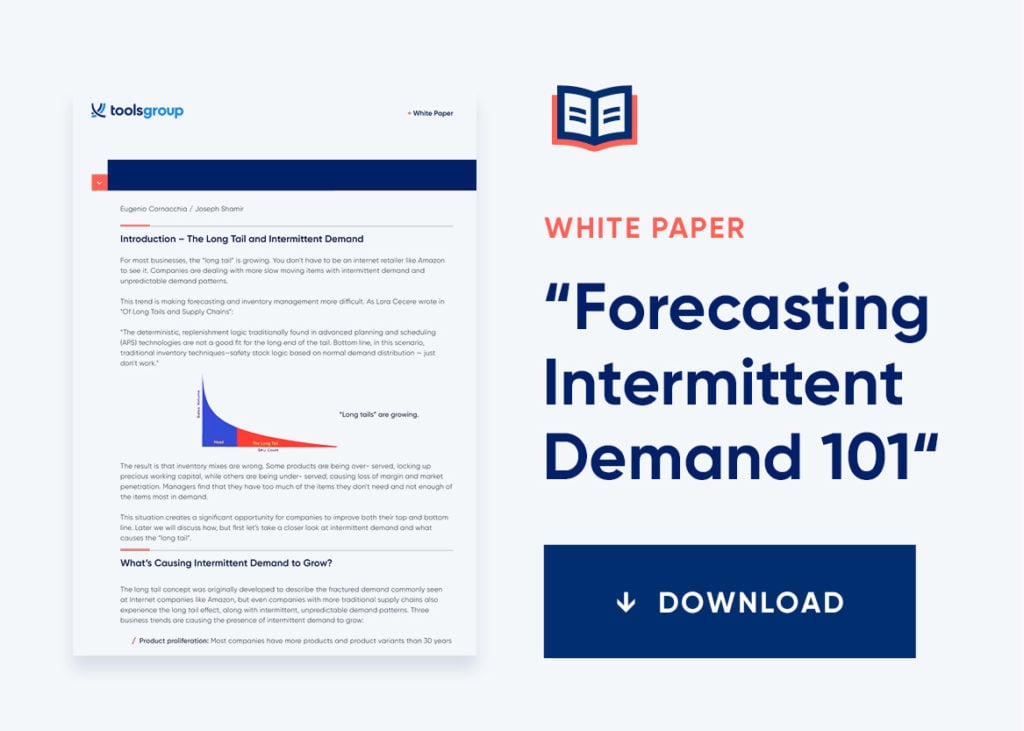Forecasting the Long Tail and Intermittent Demand
Items with intermittent, unpredictable or “long tail” demand are a growing part of business. You don’t have to be an internet retailer like Amazon to see it. Companies are dealing with more slow moving items with unpredictable demand patterns. This is making demand forecasting and inventory management more difficult, and the ability to recognize predictive demand signals more vital.
Why the long tail is growing and its implications
Retailers typically have a long tail. It comprises more than 95% of all SKUs and 79% of revenue for one large internet retailer. But even a branded fast-moving consumer goods (FMCG) company we know has intermittent demand that accounts for 86% of their SKUs and nearly half of their revenues.
Three trends are causing growing tails:
- Product proliferation – more products and variants mean splitting demand and inducing higher variability at the individual SKU level
- More frequent replenishment – faster delivery and reactions to demand changes require shorter replenishment time buckets which trigger more many periods of zero demand, interspersed with lumpy demand spikes
- Extended supply chains – increased collaboration between vendors, distributors and retailers provides downstream demand visibility closer to the end customer. Demand is disaggregated into smaller streams where intermittent behavior becomes common
Traditional supply chain solutions were not designed for high variability demand. Inventory mixes and service levels get out of balance across the network—and out of line with business objectives. Planners compensate by manually adding inventory that accumulates in the tail. Inventory mixes become wrong. Some products are over-served, locking up precious working capital, while others are being under-served, and causing loss of margin and market penetration.
It can also induce a “bullwhip effect”. Planners focus on the “head” and manage the “tail” as exceptions, generally causing extensive manual interventions. Due to the difficulty of planning such inventories, they tend to act directly on replenishment orders, with a risk and tendency to overreact. This manually induced bullwhip effect creates overstock in the tail that accumulates over time and frequently leads to obsolescence.
The solution is not forecast accuracy
The critical issue related to dealing with SKUs in the tail is that with intermittent demand there are many zero-demand periods. This causes demand variability to be very high and demand probability distributions to be highly skewed.
This “intrinsic variability” caused by low order frequency has very little to do with forecast accuracy. For instance, if an SKU has average sales of one unit every ten days, and the daily forecast is close to 0.1, the forecast is quite accurate overall. The problem is that it is very difficult to predict when the next demand will occur and how big it will be. So any attempt to improve “forecast accuracy” will likely be useless, since it will not lead to any relevant reduction in perceived demand variability. A far more effective approach is to analyze the full probability distribution and create a reliable statistical description of how the demand behaves.
So the key to forecasting the long tail is modeling the probabilities of future demand. Unlike forecasting a single demand number, viewing a range of demand behaviors helps you make better trade-offs and decisions on how to deliver service. Firms can concentrate on the probability of future events occurring, using predictive demand signals, and the risks to working capital and service level performance.
Don’t get caught up in the forecast accuracy bandwagon—it helps for the head items, but it’s only a small part of the solution for the tail. There, it’s about identifying the range of possible outcomes, then leveraging stock policies and inventory optimization to deliver service and mitigate risk.
Forecasting long tail demand using predictive demand signals
Three capabilities help forecast demand behavior and probability distributions across a wide variety of demand patterns:
- Reliable demand modeling – works across a wide range of SKU behavior types to understand all elements of demand uncertainty and forecast error, including the intrinsic demand variability caused by order-line frequency and order-line size distribution
- Advanced inventory modeling – describes statistical inventory behavior, eliminating the gross approximations of traditional inventory management theory
- Demand signal propagation – combines demand and inventory modeling to model the impact of replenishment policies and constraints at each echelon of the supply chain
These capabilities can lead to significantly different supply chain planning outcomes. For instance, one multi-channel CPG manufacturer found that two SKUs sold less than one case per day on average, so their traditional forecasting and inventory management software recommended the same safety stock target for both. But one SKU’s demand consisted of many small orders, relatively easily handled by a small amount of stock; the other a few large orders requiring much more inventory to handle each order.
When the company implemented a solution that properly understood long tail demand, it got a target of 28 days of inventory for one SKU and 155 days for the second. The approach worked—the company was able to optimize inventory and service levels—finding an efficient inventory mix that hit its target of a 99.6% case-fill rate.
Forecasting long tail demand is challenging, but quite doable with the right tools.
Click below for a white paper on forecasting long tail demand:







